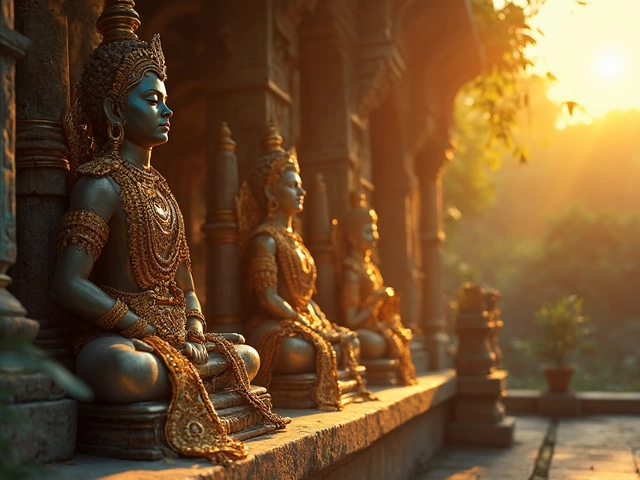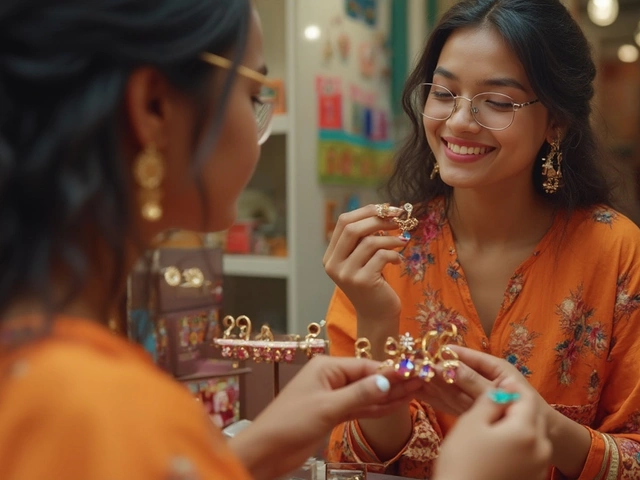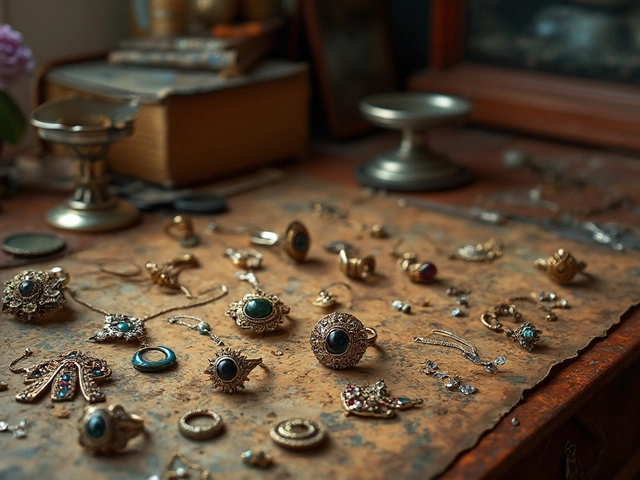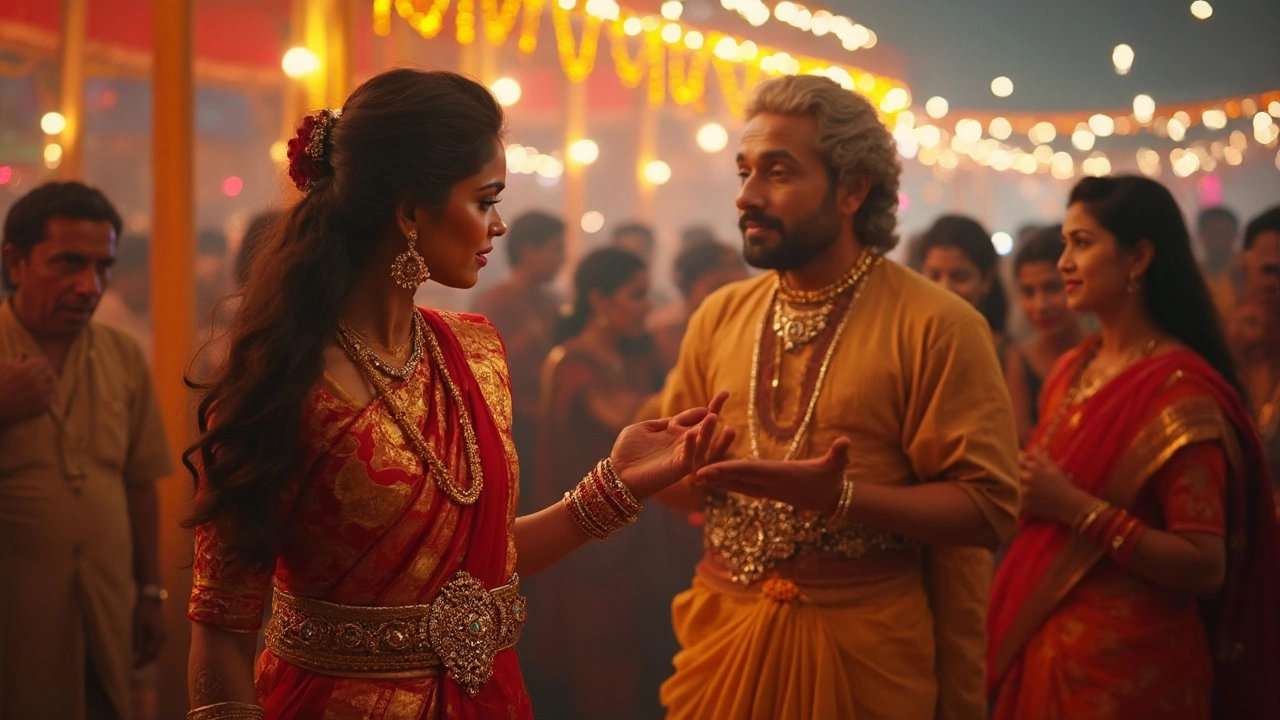
The waist chain—“kamarbandh” in Hindi—might look like just jewellery, but in India, it’s packed with old-school meaning. You’ll see it in temples, weddings, and even old family photos. Sometimes, it’s thin and hidden under sarees; other times, it’s so blingy, you can’t miss it. It’s not just about looks. People believe kamarbandhs protect, bless, and show off status or marital vibes.
Walking around any Indian town during festival season, you’ll spot shop windows full of these chains—some with tiny bells, coins, or sacred symbols dangling from them. It’s a tradition that’s stuck for centuries. Even kids get tiny versions for temple ceremonies or birthdays. The best part? Each waist chain tells a story, whether about family, faith, or just personal style.
- What Exactly is an Indian Waist Chain?
- The Deeper Cultural and Religious Meaning
- Styles and Who Wears Them
- Practical Tips for Wearing and Choosing a Waist Chain
- Temple Jewellery’s Role in Today’s World
What Exactly is an Indian Waist Chain?
An Indian waist chain, often called a “kamarbandh” or “ottiyanam” in South India, is a type of jewelry that sits right around the waist. It’s usually made from gold or silver, but you'll also find versions with beads, colorful stones, or even diamonds if you walk into big jewellery stores. Some have coins, bells, or tiny pendants for added detail. The main point: it’s meant to highlight the waist and finish off traditional outfits, especially sarees and lehengas.
Waist chains aren’t a one-size-fits-all thing. You’ll notice that different regions have their own styles. For example, the thick, boldly designed waist belts (ottiyanam) in Tamil Nadu temples look nothing like the delicate, multi-layered chains popular in Rajasthan. And while women mostly wear them during festivals or weddings, you’ll also spot little kids and, in some temples, men tying on special varieties during rituals for good luck.
These chains aren’t just for show. In old Indian households, the kamarbandh was believed to keep posture in check and even help with back support—think of it as ancient bling with a side of comfort. For newborns, a thin silver chain is sometimes given to bring them good fortune right from the start. Today, though, they’re mostly about tradition and making festival outfits stand out.
Indian waist chain is a keyword you’ll see everywhere when looking into temple jewelry. The reason? It’s a classic piece. Whether you’re searching online or in a market, ask for this, and you’ll find chains for every age, gender, and occasion.
The Deeper Cultural and Religious Meaning
Temple jewellery in India, especially the Indian waist chain, isn’t just about style. For ages, wearing a chain around the waist has connected people to tradition and faith. In Hindu temples, you’ll spot both men and women—sometimes even kids—wearing these chains during important rituals. People believe they offer protection, keep negative energy out, and bring in positive vibes, kinda like a portable blessing.
For women, the waist chain often signals a rite of passage. It might be gifted at puberty, marriage, or during big festival days like Pongal or Navratri. In some families, elders say it keeps a woman grounded, both physically and spiritually. Lots of folks link the chain’s snugness to focus, as it encourages mindfulness in movement—think of it as ancient body awareness, not that different from what yoga fans talk about nowadays.
Besides personal beliefs, there are regional twists. In South India, temple dancers like Bharatanatyam artists always wear elaborate kamarbandhs as part of their costume. The chain isn’t just for looks—it has to jingle with the footwork, making every step part of the performance. In parts of Rajasthan and Gujarat, gold-plated or silver versions often come with religious symbols like the Om or Ganesha, turning the jewellery into a protective charm.
Here’s a quick look at how many roles the waist chain covers in Indian culture:
- Believed to protect and ward off evil, especially for newborns and brides.
- Worn as a sign of marital status, wealth, or clan identity in different regions.
- Blessed by priests during temple visits or big life moments.
- Used in dance rituals, marking every movement to connect to tradition.
| Role | Example | Main Region |
|---|---|---|
| Protection | Children get silver chains after naming ceremony | Tamil Nadu |
| Dance Ritual | Bharatanatyam dancers wear ornate waist chains | South India |
| Marital Symbol | Brides wear gold-plated kamarbandhs at weddings | Maharashtra, Rajasthan |
| Clan/Social Identity | Chain designs show family or village | Gujarat, Odisha |
You’ll find priests often bless these chains with holy water before someone puts them on, especially in temple towns like Madurai or Ujjain. Even today, many carry on the ritual because, let’s face it, everyone could use a little extra luck and connection to the old ways. And unlike random fashion trends, the tradition of the Indian waist chain just keeps rolling into the next generation.
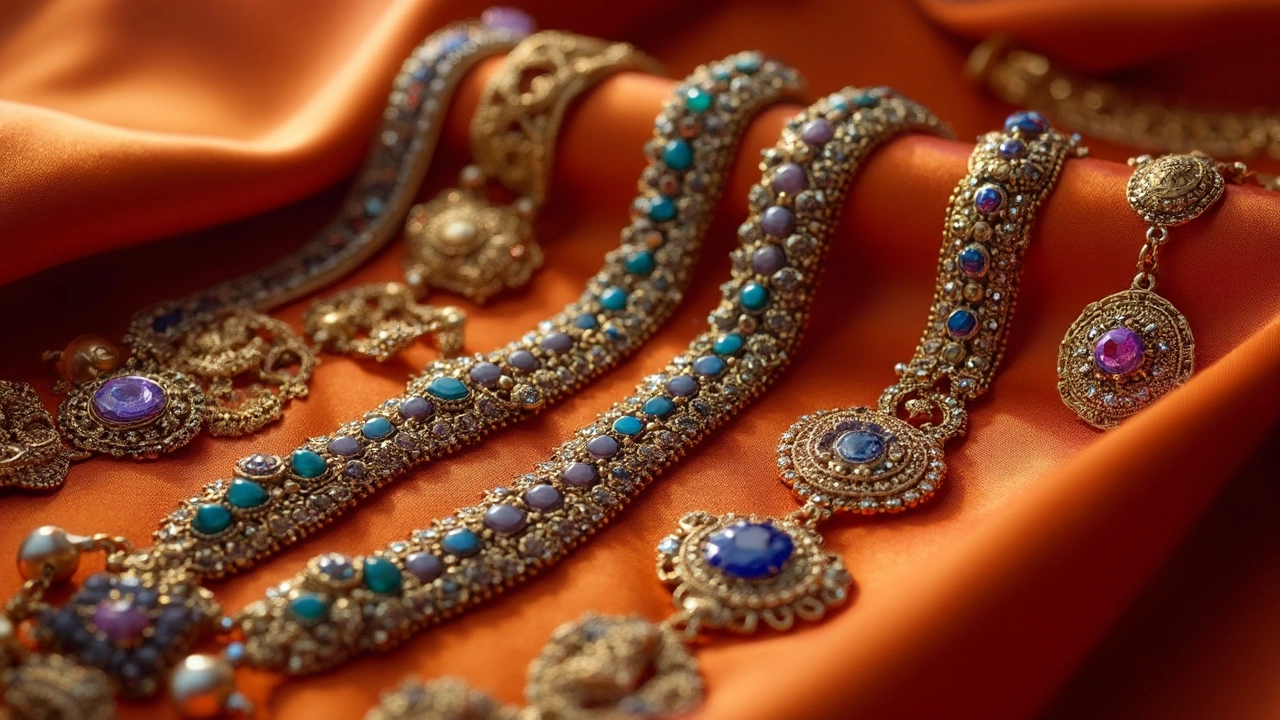
Styles and Who Wears Them
If you think a waist chain is just a one-style-fits-all thing, think again. In India, there’s a crazy variety of designs, metals, and purposes behind these little circles that sit on your hips. Some are chunky and dramatic, while others are so thin you’d miss them unless you got real close. And it’s not just a women’s thing—men, kids, and even tiny babies get in on the action, especially at special events or temple visits.
Let’s break it down:
- Temple Jewellery: These are usually crafted from silver or gold, loaded with symbols like Lakshmi coins, bells, or images of gods. The sound of the bells is said to keep away bad vibes during rituals.
- Modern Styles: Lightweight, sometimes with just a single charm, modern versions can even double as fashion accessories. Some folks wear them just under their work clothes for a secret confidence boost.
- Regional Variations: South India loves bold gold kamarbandhs at weddings, while in North India, slim silver chains are more common, especially with sarees or lehengas.
- Kids & Babies: Newborn babies sometimes get simple, adjustable chains that are believed to protect their health. It’s also pretty common to see children getting one as part of their first temple ceremony.
- For Men: Yup, men too! Hindu priests and dancers might wear silk or gold-wrapped waist threads as part of their temple outfits or performances.
It turns out that the Indian waist chain has stuck around for so long partly because it’s flexible. People tweak the style to suit their age, tradition, or just how much they want to stand out in a crowd.
Here’s a quick look at how waist chain styles break down across India:
| Region | Common Material | Typical Wearers | Occasions |
|---|---|---|---|
| South India | Gold, Temple Jewels | Brides, Temple Dancers | Weddings, Religious Festivals |
| North India | Silver | Married Women, Girls | Festivals, Daily Wear |
| Western India | Silver, Beads | Tribal Women, Kids | Folk Festivals, Rituals |
| Eastern India | Gold & Silver Plated | Priests, Young Babies | Temple Visits, Naming Ceremonies |
Bottom line: whether you’re a bride decked out for a big day, a kid at a temple, or just adding a bit of flash to a regular outfit, there’s a waist chain style out there for you. It’s all about what feels right and fits your story.
Practical Tips for Wearing and Choosing a Waist Chain
Picking the right waist chain isn’t as simple as grabbing the shiniest thing at the shop. There are a few things to check—comfort, metal type, fit, and where you’ll wear it. For starters, always try it on before buying. A good waist chain should rest comfortably on your hips without pinching or digging in. If you’re buying online, measure around the part of your waist or hip where you want it to sit, plus add an extra half-inch for easy movement.
Now, let’s talk about types. Gold and silver are common, but in temple ceremonies, pure silver is still the go-to choice because it’s considered auspicious. Everyday wearers might go for lighter, nickel-free alloys that don’t trigger allergies. Here’s a quick comparison to help you out:
| Material | Durability | Allergy Risk | Occasion |
|---|---|---|---|
| Gold | High | Low | Weddings/Grand Events |
| Silver | Medium | Very Low | Temple/Traditional |
| Alloy | Varies | Medium/High | Daily/Fashion |
Another thing—go for adjustable clasps. That way, whether you eat too many ladoos at a festival or just want a different fit, you’re sorted. If you’re new to wearing them, start with a lightweight chain. Heavy, stone-studded ones look great at weddings but can get annoying if you wear them all day.
- Keep your waist chain clean by wiping it down after each wear, especially in hot weather.
- Don’t sleep wearing a chain—links can twist and weaken.
- If you notice any skin rash, switch to hypoallergenic options.
- Store it in a cloth pouch, and away from perfume bottles or chemicals.
Styling matters, too. For sarees or lehengas, wider chains with dangling charms look classic. Jeans or skirts? A sleek, minimalist chain will fit right in. If you’re gifting one, pick a basic design—these are pretty much ageless and work across generations.
"Waist chains aren’t just an accessory, they’re a tradition—pick one that honors your story, but don’t forget comfort comes first," says Sunita Rao, co-founder of Temple Jewels India.
If you’re wondering which size or type will flatter your shape, here’s a trick: try different waist heights with your outfits at home, then snap mirror selfies to see what works. At the end of the day, confidence is the best add-on to any Indian waist chain.

Temple Jewellery’s Role in Today’s World
These days, temple jewellery isn’t just about rituals or classical Indian dance. You’ll spot waist chains even at modern parties and on Instagram influencers. They’re not limited to old traditions—people blend them with jeans, skirts, or even over fancy dresses. Big brands like Tanishq and Senco Gold have started fresh lines to meet younger tastes, but the real attraction is still the classic designs with gods, bells, and little charms.
If you visit a South Indian wedding, it’s almost a guarantee that you’ll see brides showing off heavy, elaborate temple jewellery—especially Indian waist chain styles. Gold remains the top choice, but silver, imitation, or even beaded versions are everywhere now. People love the mix of history and style. And some still believe wearing these chains can protect you from ‘bad vibes’—a belief that’s lasted centuries.
There’s also a growing market for temple jewellery outside India, with Bollywood and Tamil cinema helping to spread the trend globally. NRIs order these pieces online, especially for big festivals like Navratri and Diwali. Want some numbers? Here’s a quick look at how much temple jewellery matters today:
| Year | Temple Jewellery Market Value (India, INR Crore) | Global Growth (%) |
|---|---|---|
| 2019 | 2,200 | 8 |
| 2023 | 3,150 | 11 |
| Estimated 2025 | 3,800 | 12 |
If you’re thinking about buying a waist chain or gifting one, check authenticity markers—real temple jewellery is often handcrafted, usually heavier, and has unique motifs. Most shops give a purity certificate if it’s gold. And don’t skip local artisans; their work is seriously impressive and often supports whole families.
So, whether you want a waist chain for its look, the tradition, or a dash of family nostalgia, there’s no wrong reason to wear one. In 2025, they’ve definitely moved from temple halls to being a statement piece for every generation.
